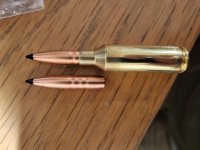Benjblt
Member
The color codes are demonstrate how far you need to break it down for someone like meThose primers are pretty, but an ejector smear on a bolt gun case head is not good. There's a slight chance your ejector spring is stout, but 99% of the time this is over pressure.
That is common in stout to over pressure loads. Common occurrence. Means a different powder should be selected.
N570 is a pretty slow powder for your application. I should think N560 & N165 will bring you on home. Interesting to see the Hornady data showing only a grain difference between N560 & N165. These two powders are currently a mystery to be solved recently on Hammer Time.
Ya'll know I'm getting serious when I'm breaking out the color codes!
I'm not seeing that round smear on all four shots of each powder charge but I do see it. There's also some half arcs on some of them. I'm not sure what that is. On the lower charge weights I'm not seeing those marks.
Do you mind explaining?
N570 was a mistype. I corrected it above. I'm using N560.


